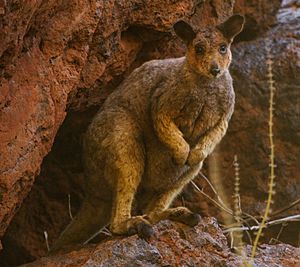Rothschild's rock-wallaby facts for kids
Quick facts for kids Rothschild's rock-wallaby |
|
|---|---|
 |
|
| Conservation status | |
| Scientific classification | |
| Genus: |
Petrogale
|
| Species: |
rothschildi
|
 |
|
| Rothschild's rock-wallaby range | |
The Rothschild's rock-wallaby (Petrogale rothschildi) is a special type of macropod. It is also called the Roebourne rock-wallaby. These animals live in Western Australia. You can find them in the Pilbara area and the Dampier Archipelago.
Even though they are not currently in danger, they face a threat from the red fox (Vulpes vulpes). Rothschild's rock-wallabies are among the biggest rock-wallabies. They are mostly golden-brown with a greyish color on their neck. This grey often looks a bit purple. They are mostly active at night and eat grass. They usually live in rocky places.
Contents
What is a Rothschild's Rock-Wallaby?
The Rothschild's rock-wallaby is known as one of the most beautiful types of rock-wallabies. It is also one of the largest in its group. Its fur is a golden-brown color on its back. This color turns greyish on its shoulders and the back of its neck.
The top of its head and nose are dark brown. This color stands out against the lighter grey-buff color on its lower nose. This lighter color goes from below its eyes to the top of its ears. Sometimes, its fur has a purple tint, especially on its shoulders and head.
How Big Are They?
A Rothschild's rock-wallaby's head and body together measure about 47 to 60 centimeters (18 to 24 inches). Their tail is very long, about 55 to 70 centimeters (22 to 28 inches). The last third of their tail is dark brown.
Their ears are about 5.6 centimeters (2.2 inches) long from tip to base. These wallabies usually weigh between 3.7 and 6.6 kilograms (8.2 to 14.6 pounds). However, those living on the islands of the Dampier Archipelago are smaller. They weigh from 2.6 to 3.5 kilograms (5.7 to 7.7 pounds).
Where Do They Live and What Do They Do?
Rothschild's rock-wallabies hide during the day. They find shelter in cool cracks and caves in their rocky homes. They are very shy animals. They use the rocky land to stay hidden from animals that might hunt them.
You can find them near hills covered with plants, piles of rocks, and on cliff faces. At night, they come out from their hiding spots to eat. They look for green plants like grasses in the sandy areas nearby. These wallabies need water and places to find food close to their daytime shelters.
What Do They Eat?
Their diet includes buffel grass and other leafy plants. They also eat fruits from native Ficus trees. On West Lewis Island, where they were moved, they also eat prickly pear.
They often hide in caves, cracks, or fallen cliffs. Sometimes, they even use piles of rocks or railway banks made by iron ore mining.
Where Can You Find Them?
Rothschild's rock-wallabies live only in the Ashburton and Pilbara regions of Western Australia. They are known to live at Burrup Peninsula and in the Chichester Range and Hamersley Ranges.
They also live on some islands in the Dampier Archipelago. These islands include Burrup, Dolphin, Enderby, and Rosemary islands.
Moving to New Homes
Because of sand mining on Enderby Island, some wallabies were moved. A group was successfully moved to nearby West Lewis Island. We don't think their living area has shrunk much over time. In fact, new sightings in 2013 showed they live in a larger area to the south and east.
The southernmost places they have been seen are Newman, Barlee Range, and Wanna Station. They have been recorded as far north as Marble Bar and west at Woodstock Station.
Protecting Rothschild's Rock-Wallabies
The Rothschild's rock-wallaby is not listed as endangered by Australian state or federal governments. However, a plan was made in Western Australia in 2013. This plan included this wallaby among five rock-wallaby species that need help. The goal is to protect them from things that threaten their populations.
Threats They Face
The arrival of the red fox (Vulpes vulpes) is thought to have caused some wallaby groups to disappear. This happened on East and West Intercourse islands. Fox control programs have helped wallaby numbers get better in places where they were declining.
Sometimes, red foxes can reach the islands where the wallabies live. This happens when the coastline changes, creating a path for the foxes. This causes a threat to the island wallaby groups.
Mining for iron ore in the region has also affected these wallabies. Future mining plans are expected to impact even more of their living areas. When their homes are destroyed by mining, wallabies have been moved to new places. More road traffic from the natural gas industry in northwest Australia has also led to more wallabies being hit by cars.


